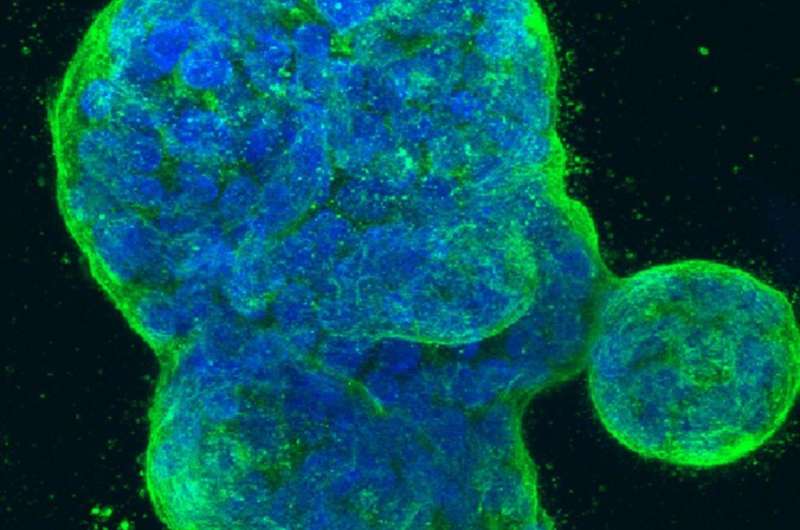This article has been reviewed according to Science X's editorial process and policies. Editors have highlighted the following attributes while ensuring the content's credibility:
fact-checked
peer-reviewed publication
trusted source
proofread
More than 900 chemicals, many found in consumer products and the environment, display breast-cancer causing traits

With tens of thousands of synthetic chemicals on the market, and new ones in development all the time, knowing which ones might be harmful is a challenge both for the federal agencies that regulate them and the companies that use them in products. Now scientists have found a quick way to predict whether a chemical is likely to cause breast cancer based on whether the chemical harbors specific traits.
"This new study provides a roadmap for regulators and manufacturers to quickly flag chemicals that could contribute to breast cancer in order to prevent their use in consumer products and find safer alternatives," says Dr. Jennifer Kay, a research scientist at Silent Spring Institute. Dr. Kay is lead author of a study titled "Application of the Key Characteristics framework to identify potential breast carcinogens using publicly available in vivo, in vitro, and in silico data," published in Environmental Health Perspectives.
Breast cancer remains the most commonly diagnosed cancer in the United States. Recent data show rates increasing in young women, a trend that can't be explained by genetics. "We need new tools to identify environmental exposures that could be contributing to this trend so we can develop prevention strategies and reduce the burden of the disease," says Kay.
Hormone signals
Kay and her colleagues searched through multiple international and U.S. government databases to identify chemicals that have been found to cause mammary tumors in animals. The databases were from the International Agency for Cancer Research (IARC), the National Toxicology Program, the U.S. Environmental Protection Agency (EPA), and the National Cancer Institute, among others.
The researchers also looked at data from EPA's ToxCast program to identify chemicals that alter the body's hormones, or endocrine disruptors, in ways that could promote breast cancer. The team looked specifically for chemicals that activate the estrogen receptor—a receptor present in breast cells—as well as chemicals that cause cells to make more estrogen or progesterone, an established risk factor for breast cancer.
The researchers identified a total of 921 chemicals that could promote the development of breast cancer. Ninety percent of the chemicals are ones to which people are commonly exposed in consumer products, food and drink, pesticides, medications, and workplaces.
A breakdown of the list revealed 278 chemicals that cause mammary tumors in animals. More than half of the chemicals cause cells to make more estrogen or progesterone, and about a third activate the estrogen receptor.
"Breast cancer is a hormonal disease, so the fact that so many chemicals can alter estrogen and progesterone is concerning," says Kay.
Since damage to DNA can also trigger cancer, the researchers searched additional databases and found that 420 of the chemicals on their list both damage DNA and alter hormones, which could make them riskier. What's more, the team's analysis found that chemicals that cause mammary tumors in animals are more likely to have these DNA-damaging and hormone-disrupting characteristics than ones that don't.
"Historically, chemicals that cause mammary tumors in animals were seen as the best predictor of whether they might cause breast cancer in humans," says co-author Ruthann Rudel, director of research at Silent Spring. "But animal studies are expensive and time-consuming, which is why so many chemicals have not been tested. Our findings show that screening chemicals for these hormonal traits could be an effective strategy for flagging potential breast carcinogens."
A roadmap for safety
Over the past decade, there has been growing evidence that environmental chemicals are important contributing factors in the development of cancer. A number of studies in people have found links between breast cancer and pesticides, hair dyes, and air pollution. Other studies suggest exposure to hormone-disrupting chemicals early in life, in the womb or during puberty, can alter breast development in ways that could increase the risk of cancer later on.
To observe those associations, however, scientists have to wait until hundreds or thousands of children and women have been exposed to a chemical and check, often many years later, to see who develops breast cancer. "It's not feasible, nor is it ethical, to wait that long," says Rudel. "And it's another reason why we need better tools for predicting which chemicals are likely to lead to breast cancer so we can avoid those exposures."
The Silent Spring study could have implications for how EPA assesses chemicals for safety. For instance, the chemicals identified in the study include more than 30 pesticides that EPA previously approved for use despite evidence linking the chemicals with mammary tumors.
This fall, EPA proposed a new strategic plan to ensure that pesticides are evaluated for their effects on hormones. The study authors hope their new comprehensive list of breast cancer-relevant chemicals, which includes hundreds of endocrine disruptors, will inform EPA's plan and better protect the public from harmful exposures.
Additional co-authors of the new study include Megan Schwarzman at UC Berkeley and Julia Brody at Silent Spring Institute.
More information: Application of the Key Characteristics framework to identify potential breast carcinogens using publicly available in vivo, in vitro, and in silico data, Environmental Health Perspectives (2024). DOI: 10.1289/EHP13233. ehp.niehs.nih.gov/ehp13233

















